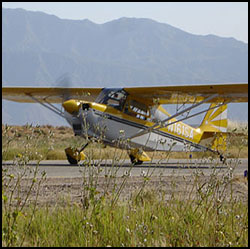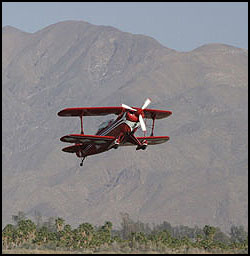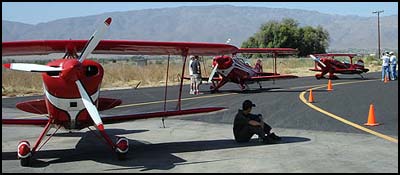It’s hard to believe that nearly a month has passed since I flew my first aerobatic competition. But alas, that’s what the calendar tells me.
 In fact, I’m getting ready to leave for another one — this time at Apple Valley — on Thursday morning. I’m stepping up to the Sportsman category because I did pretty well at Borrego — in fact, I won. That’s not saying much, because there were only a few others in my category, but I’ll take it. Incidentally, I also received the Challenge Award as the highest scoring pilot flying an aircraft with less than 180 hp.
In fact, I’m getting ready to leave for another one — this time at Apple Valley — on Thursday morning. I’m stepping up to the Sportsman category because I did pretty well at Borrego — in fact, I won. That’s not saying much, because there were only a few others in my category, but I’ll take it. Incidentally, I also received the Challenge Award as the highest scoring pilot flying an aircraft with less than 180 hp.
Competition aerobatics is interesting. I love it, but it bears little resemblance to the stuff I learned in the Basic AB course. Sure, we mastered spins, loops, rolls, cubans, hammerheads, immelmans, and so on, but once you move into competition things change. Instead of flying solely for safety, we’re flying for performance. Instead of flying to please only yourself, the criteria becomes “how does this look from the ground?”.
The short answer is “not good”, unless you’re ready to fly as though you want to break the plane. Get comfortable with Vne (‘never exceed’ speed), because you’re going to spend a lot of time there. Maneuvers feel far more violent and uncoordinated. Rolls are initiated with zero rudder (boy did that take some getting used to!). Errors remain intentionally uncorrected. But it looks great from where the judges sit, and that’s what counts.
So those were my initial impressions. Now that I’m used to it, it feels normal. But the transition from the old way of flying these manuvers to the way I do it now was awkward. Everything felt wrong. The aforementioned aileron roll (officially referred to as a ‘slow roll’) is a good example.
 Aileron rolls are classically initiated by raising the nose before rolling the wings. This is done to allow for the drop in pitch which inevitably occurs when you bank the wings and lift is redirected horizontally.
Aileron rolls are classically initiated by raising the nose before rolling the wings. This is done to allow for the drop in pitch which inevitably occurs when you bank the wings and lift is redirected horizontally.
However, in competition, no altitude can be gained or lost while executing the slow roll. So you begin the roll from level flight with no rudder. Aileron drag pulls the nose upward as you roll, and as the aircraft moves to knife-edge, top rudder is used to hold it there while the plane transitions to inverted flight, where even more rudder is required to keep it on heading. This is also the point where forward elevator is needed to hold the nose up. As the aircraft rolls to opposite knife-edge, there is a sudden call for opposite rudder (which is now “top” rudder) to hold the nose up while the roll continues back around toward level flight.
Just a little more complex than “raise the nose and roll it over”, eh? An aileron roll at 80 mph requires serious control input in the Super Decathlon. From what I’ve heard, it’s significantly easier in airplanes with a faster roll rate like an Edge, Extra, or Sukhoi.
Another aspect of competition flying that took some getting used to was the concept of drawing lines before and after each figure. This was especially strange after a spin, because non-competitors are taught to keep the throttle at idle, and to recover to level flight as soon as the stall is broken. This makes sense. You don’t want to build the airspeed to a dangerous level.
Competition style spins, on the other hand, require drawing a significant downline while building speed for the next maneuver. So once you’ve un-stalled the airplane, it’s back to full power and maintain the downline as the airspeed indicator screams toward redline. You have to build the speed quickly or you’ll bust through the bottom of the aerobatic box (1500′ AGL) and be disqualified.
The competition spin brings up another big change. Pilots are traditionally taught to fix any mistakes in their flying as soon as they see them. Off heading? Fix it! Altitude a little low? Then fix it! Once you enter competition, that stops. If you’re off heading, don’t fix it, lest you draw the judge’s attention to that fact and incur a penalty. It took tremendous willpower to exit a spin just a few degrees off heading and yet do nothing about it.
The Borrego contest was a ‘mini’ event, featuring primary and sportsman categories alone. It’s designed to be a good place for newbies like myself to make their first foray into sport aerobatics. And it was, largely because many of us were able to get some time in the box in advance of the competition.
Sunrise held a training camp at Borrego in the days before the contest, which provided valuable input from coaches who were watching me fly from the ground rather than in the back seat of the aircraft. I thought this was the best thing since sliced bread! Getting the coach out of the airplane meant that the weight and balance was the same as it would be during the competition. And flying in the actual aerobatic box rather than a high altitude practice area with no accurate ground reference allowed me to answer other questions like “where do I hold while waiting for my turn in the box?” and “how hard will it be to see the box markers on the ground?” I used the Google Maps satellite feature to scope out the box in advance, but it’s not the same as actually being there.

Aside from the flying, the week spent in Borrego was great. The other competitors are extremely nice. Sure, they fly hard to beat you in the air. But on the ground everyone is friendly and helpful, almost to a fault. You have to be. These contests don’t work without a virtual army of volunteers. Judges assistants, scorers, registrars, boundary judges, runners, starters, refuelers, and more. When you’re not flying, you’re either preparing to fly, or helping someone else get ready to fly. Push an airplane to the fuel pit. Help someone strap on a parachute or find a missing sequence card, etc.
Borrego itself is a fascinating town. If you ever want to try a joint with some local flair, I recommend Carlee’s. It’s a relatively small diner & bar with lots of charater. Just call ahead and make sure it’s not karaoke night. (Don’t ask). Carlee’s seems to be a window into what Palm Springs would have been like fifty years ago. Put Sinatra on a bar stool with a glass of Jack Daniels and the picture would be complete. In fact, Borrego itself is sort of a Palm Springs from yesteryear. I understand they used to be about the same size. One took off and the other didn’t.
There’s a private airstrip just south of Borrego Airport, and one of the IAC36 members has a home on it. We congregated there after the competition for some food and an informal awards ceremony. The house is basically a massive box hangar, but finished with polished floors, white carpeting, leather couches, crown moulding, central air, a travertine lap pool, waterfalls, gourmet kitchen, rooftop viewing deck, etc. In other words, just your typical hangar. Except you could eat off any surface in it, including the airplane.
Borrego is a great place to go for the day, or to see the wildflowers bloom in the spring. The restaurant on the field is pretty well regarded. They have a lot of aviation memorabilia inside, along with aviation murals on the walls, plus an endearing yet half-deaf bartender. On days when it’s hot (aka “summer”), you can sit at the bar inside, have a cool drink, and watch the airplanes come and go. The view is better from the rooftop deck, but it’s not air-conditioned.
I guess I’d sum up the Borrego experience by noting that it has the kind of character I’d love to see in more GA airports. Instead of presenting onlookers with a wall of barbed wire, L08 says “welcome”.
If you want to attend a competition, I recommend the Borrego AkroFest in the fall (Oct 13-15, 2005). The MiniFest in the spring has only the lower categories, but the fall contest has the unlimiteds, so you’ll get to see the 4 minute freestyles and other stuff like that. It’s like a free airshow, but without the crowds and stinky jets.
So that’s what I’ve been up to lately. Flying, flying, and uh, flying. Plenty of photos of the training camp and competition at Borrego are available for your viewing pleasure.

Congratulations on the win, Ron! Nice to see you’re still alive. Put me on your mailing list for updates on where you’ll be flying. It’d be fun to bring my boy out to see it.
Thanks Jon. I’ll be competing at Apple Valley (near Victorville) this Friday and Saturday if you want to check it out.
Holy moly, Ron! That is so cool! Congratulations. I would love to experience the aerobatics as a passenger… possible?
School’s done. Tacos next Tuesday?
Works for me! And yes, I think we can get you an aerobatic demo ride. You can even do some of the flying (provided you stayed at a Holiday Inn last night).